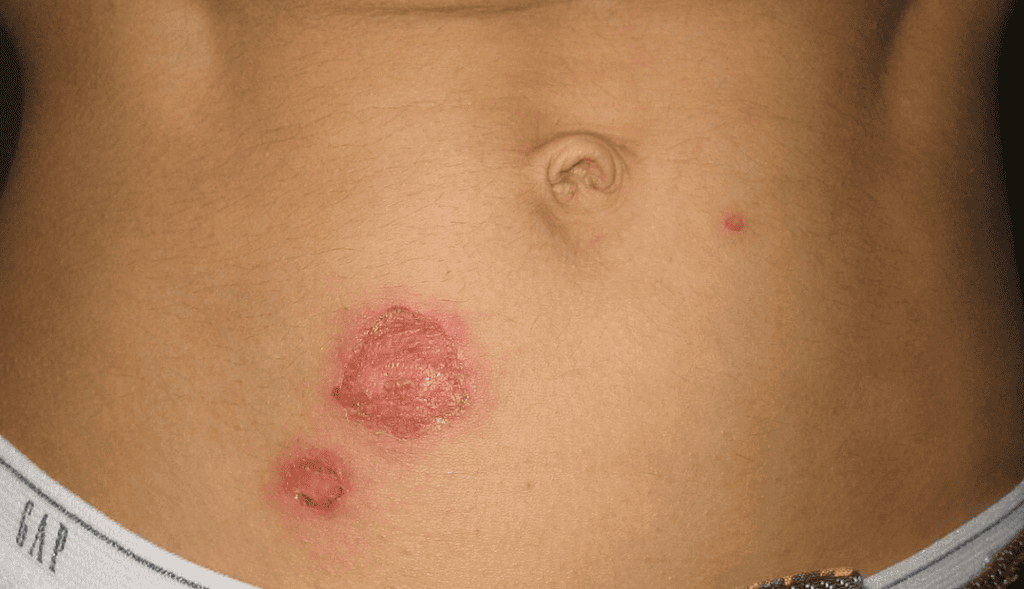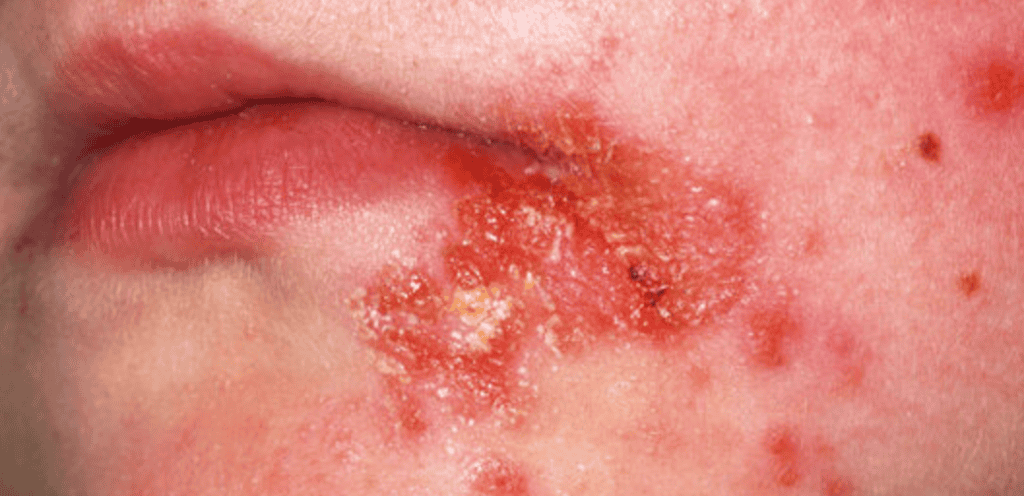Get Treated for Impetigo
FREE NHS TREATMENTS
Learn More About the Medications That Can Treat Impetigo
MEDICAL INFORMATION
Impetigo Key Facts

September 17, 2025 (Current Version)
September 24, 2024
Impetigo (im-puh-TIE-go) is a highly contagious bacterial skin infection which can affect anyone of any age although it is more common in infants and young children between 2 and 5 years of age. Indeed, it is the most common skin infection in young children in the UK.
Impetigo usually starts by presenting as red sores or blisters on the face, particularly around the nose and mouth. It can also appear on the hands and feet. The red sores may be harder to see on black or brown skin. After a week, the sores typically burst and develop into honey-coloured crusts or patches.

Impetigo can resolve within 7 to 10 days if it is treated with antibiotics.
What are the causes of Impetigo?
Impetigo is caused by two specific bacteria:
- Staphylococcus aureus
- Streptococcus pyogenes
The bacteria infects the skin by two routes:
- Cuts, insect bites or other skin injury (this is known as Primary Impetigo)
- Skin damage caused by eczema, scabies or head lice (this is known as Secondary Impetigo)
The bacteria can easily spread through close contact with someone who already has the infection. This can be through direct physical contact, or by sharing towels or flannels. Symptoms don’t present for at least 4 days and in some cases up to 10 days, therefore it can be easy to unintentionally spread it.
Apart from children who are prone to impetigo, other groups can also be at high risk of developing impetigo:
- Diabetics
- People who are immunocompromised through conditions such as HIV
- People who are immunocompromised through taking medications that reduce their immune system.
What are the symptoms of Impetigo?
The first signs that indicate you may have Impetigo are:
- Red sores (non-bullous impetigo)
- Blisters (bullous impetigo)
- Sores or blisters that burst to form crusty patches
What is Bullous Impetigo?
Bullous impetigo begins with the appearance of fluid-filled blisters (bullae) which usually occur on the torso between the waist and neck, or on the arms and legs. The blisters can typically be 1 cm to 2 cm in dimension.
The blisters can spread quickly before bursting after a few days to leave a yellow crust which usually scabs and heals without leaving any scarring.
The blisters can be painful with the area of skin around them being itchy. Additional symptoms such as high temperature (fever) and swollen glands are also common in bullous impetigo cases.
Bullous Impetigo is less common than Non-Bullous Impetigo.

What is Non-Bullous Impetigo?
Non-bullous impetigo begins with the appearance of red sores. It presents around the nose and mouth although it can also affect other areas of the face and the limbs.
The sores burst relatively quickly and leave behind thick, honey-coloured crusts which are typically 2 cm in dimension. The honey-coloured crusts appear like cornflakes stuck to the skin. Once the crusts dry, they leave behind a red mark which usually fades without scarring. This can take between a few days and a few weeks.

The sores are not painful, although they can be itchy. To avoid spreading the infection, it is advisable not to touch or scratch the sores.
Additional symptoms such as a high temperature (fever) and swollen glands, are rare but can occur in more serious cases.
When to get advice from a GP
You should contact your GP if you suspect you have Impetigo and you have:
- Had treatment for impetigo but the symptoms changed or got worse
- Had impetigo before and it keeps coming back
Impetigo is very infectious. Check with the GP before you go into the surgery. They may suggest a phone consultation.
Check if you qualify for FREE treatment with NHS Pharmacy First, without seeing your GP
You can check your eligibility to use the NHS Pharmacy First service if you suspect you have Impetigo and you:
- Are 18 years or over
- Have not had Impetigo before
The NHS Pharmacy First service may not be suitable if:
- Serious complications suspected such as deeper soft tissue infection
- There is a risk of deterioration or serious illness
- You are immunocompromised and the infection is widespread
The NHS Pharmacy First service is available to all NowPatient users who are registered with the NHS in England. If you are exempt from paying for your prescriptions, the service and the treatments are provided free of charge. If you are not exempt from paying prescription charges, treatments are provided at the prevailing NHS prescription charge rate. There is no charge for consultations.
What NHS Pharmacy First treatments are available for Impetigo?
Treatment for Impetigo is recommended because it can reduce the length of the illness to around seven to 10 days and can lower the risk of cross-infecting others.
The main treatments prescribed are antibiotic creams or antibiotic tablets. These treatments are usually prescribed for a one-week course.
Individuals with diagnosed impetigo can return to work, school, or daycare if they:
- Have started antibiotic treatment; and
- Keep all sores on exposed skin covered
Do I have an increased risk of Impetigo?
Some people have an elevated risk of getting Impetigo, based on certain factors:
- Infections like Scabies can increase the risk of Impetigo
- Children and Infants between 2 years and 5 years of age
- People who participate in activities where cuts and scrapes are common can increase the risk of Impetigo
- Group contact with people who have Impetigo could increase the risk
- Poor personal hygiene
How can I prevent the spread of Impetigo?
If you have been diagnosed as having Impetigo, you should:
- Wash the sores with soap and water and cover them loosely with a gauze bandage or clothing
- Avoid scratching the sores or touching them
- Avoid contact with newborn babies or other infants until the risk of infection has passed
- Avoid preparing food until the risk of infection has passed
- Avoid playing contact sports until the risk of infection has passed
- Wash your hands frequently
- Not share flannels, sheets or towels with anyone who has impetigo
- Wash flannels, sheets or towels at a high temperature after use
What happens if I do not get treatment for Impetigo?
Impetigo is not usually serious and it will improve within a week of treatment or within 2-3 weeks if you are not treated,
What are the complications of Impetigo?
Although rare, some complications of impetigo can be serious. These include::
- Cellulitis
- Scarlet Fever (rare bacterial infection)
- Guttate Psoriasis (a non-infectious skin condition)
- Septicaemia (sepsis – infection of blood)
- Staphylococcal scalded skin syndrome (SSSS)
- Post-Streptococcal Glomerulonephritis (infection of blood vessels in Kidney)
- Scarring
Sources
- CDC – Impetigo
- NHS Scotland – Impetigo
- NHS – Impetigo condition
Medical Disclaimer
NowPatient has taken all reasonable steps to ensure that all material is factually accurate, complete, and current. However, the knowledge and experience of a qualified healthcare professional should always be sought after instead of using the information on this page. Before taking any drug, you should always speak to your doctor or another qualified healthcare provider.
The information provided here about medications is subject to change and is not meant to include all uses, precautions, warnings, directions, drug interactions, allergic reactions, or negative effects. The absence of warnings or other information for a particular medication does not imply that the medication or medication combination is appropriate for all patients or for all possible purposes.
Service Guide
Everything You Need to Know About NHS Pharmacy First Eligibility for Impetigo
What is NHS Pharmacy First Service for Impetigo and how does it work?
If you are aged 18 years and over, and registered with the NHS in England, you may qualify for a FREE remote video consultation and treatment for Impetigo, without having to see your GP.
NHS Pharmacy First is available to ALL NHS patients in England and will allow you to get treated for Impetigo with prescription-only medications, without having to visit your GP or obtain a prescription.
If treatments are prescribed, they are dispensed and delivered to your home or workplace from NowPatient’s online pharmacy.
The FREE service is subject to an eligibility screen.
Do you treat Impetigo through NHS Pharmacy First?
Yes. We also treat the following other conditions:
- Sinusitis
- Sore throats
- Infected insect bites
- Impetigo
- Shingles
- Uncomplicated urinary tract infections in women
Is the NHS Pharmacy First Service for Impetigo safe for me to use?
Yes. The NHS Pharmacy First Service is classified as a Class I medical device under UK MDR 2002 regulations, for its intended use. It also complies with NHS standards DTAC, DCB 0160 & DCB 0129.
How much does the service cost?
This is a FREE service for NHS-registered users in England. If you are prescribed medication for Impetigo at the end of your assessment and you are not exempt from NHS prescription charges, then you will need to pay a single NHS prescription charge. If you are exempt from prescription charges, for example, if you are on Income Support or aged over 60, then you will not be charged.
Will you have access to my GP records?
Yes, as an NHS patient, our clinicians will be able to access your GP record including medications, observations, and investigations. This ensures our clinicians are able to assess you appropriately.
Is the service secure when conducted remotely?
Yes. NowPatient operates from a HIPAA, DTAC, and Cyber Essentials Plus certified compliant platform that assures the highest levels of information security and allows us to safely handle PHI (Patient Health Information). Clinicians who access our systems do so on a zero-trust basis backed with SSO technologies.
How can I be sure the service is provided by a qualified and trustworthy clinician?
Our clinicians are board-certified pharmacists who are qualified to prescribe selected medications for Impetigo, as outlined by the NHS.
Each clinician is registered with the appropriate regulatory body—for example, pharmacists are registered with the General Pharmaceutical Council (GPhC). All clinicians undergo thorough background checks, including a Disclosure and Barring Service (DBS) check, as well as a comprehensive license verification process. When you book an appointment, you’ll be able to view the clinician’s full name, license number, and any specialist credentials.
The medications and conditions our clinicians can prescribe and treat is strictly governed, risk-assessed, and regularly reviewed in line with NHS guidelines. Our service is delivered via remote video consultations (synchronous consultations), which help ensure clinical safety and appropriate prescribing. Please note that medication is not guaranteed and is provided only at the discretion of the assessing clinician.
Do I need to provide any consents before the NHS Pharmacy First Consultation for Impetigo?
During the virtual consultation for Impetigo, we will obtain a consent from you for providing this service. This is required so we can communicate with your GP and provide information to NHS England, NHS Improvement, and the NHS Business Services Authority (NHSBSA) if required.
Is the service available in the United States and the United Kingdom?
No. At the moment, it is only available in England.
Can I use NowPatient’s NHS Pharmacy First Service for Impetigo if I live in Scotland, Wales or Northern Ireland?
This service is commissioned by NHS England and is only available to patients in England. You will not be able to use the feature if you live in Scotland, Wales, or Northern Ireland.
How do I use the NHS Pharmacy First Service for treating Impetigo?
Navigate to the NHS Pharmacy First Service Card which can be found in the ‘NHS Hub’ section of the account homepage.
Choose ‘Select Condition’ from the Options Menu on the NHS Pharmacy First Service Card and follow the steps below:
Step 1 – Choose Impetigo you would like to treat and click ‘Check Eligibility’
Step 2 – Using the AI Chat Bot, answer the questions presented to determine your eligibility for the service. If you qualify, you’ll be prompted to book a consultation. Click on the ‘Book Consultation’ button to proceed. If you do not qualify, we will signpost you to the right NHS care provider or service.
Step 3 – Now follow the instructions below to complete your booking
What happens during the NHS Pharmacy First Service remote video consultation?
During the consultation, the clinician will ask you a series of questions that will allow the clinician to assess your Impetigo and potential treatment options. At the end of the consultation, the clinician will decide if a treatment is a safe and suitable option for you.
If it is, the clinician will discuss the various treatment options that may be available, so that you can jointly agree on the option that is most suited to you. Once you have jointly agreed on a treatment plan, the clinician will issue a prescription order.
Also, with your consent, the clinician may wish to inform your doctor of the treatment that was prescribed. We recommend that you agree to this since your doctor is responsible for your overall care and they should have a record of this consultation and medication prescribed. In addition, our clinician may take the opportunity to advise you on your overall health including advice on healthy living or stop smoking.
What happens after my NHS Pharmacy First Service remote video consultation for Impetigo?
You may be sent a short survey asking you about your experience attending your remote video consultation. We encourage you to complete this as it provides us with valuable feedback to improve your experience in the future. It’s helpful for us if you point out things that didn’t go well, and suggest ways of improving the experience for you and others.
At the end of the consultation, you will receive a notification which will summarise the outcome. It will also advise you if any referrals were made to your doctor, along with any other advice that was given to you by the clinician. You will be notified of the summary via an In-App and Push notification. Once you receive the notification, navigate to ‘Notifications’ on the account homepage and you will be able to view it.
What happens if I’ve been prescribed a treatment for Impetigo?
If your attending clinician prescribes a treatment for Impetigo during the virtual consultation, you will be informed at that time. To complete your checkout, please follow the steps outlined below.
What status updates do I get after I place my order?
NowPatient uses a structured notification system for all orders, ensuring you’re consistently informed about your order status every step of the way.
You can expect status update notifications through the following channels:
- In-App
How will my order be delivered?
All orders are shipped in discreet and unmarked packaging. This means it is suitable for delivery wherever you require (home, work, or a neighbour).
For thermo-sensitive orders we use cold chain-validated packaging. Your parcel will normally receive an estimated delivery window from the courier on the day of delivery.
For your protection and safety, your first order can only be delivered to the address that is registered with NowPatient. Future orders can be delivered to any other address, for example, your workplace.
Do you ship cold-chain or temperature sensitive products?
Yes. We use a specialist courier service for all thermo-sensitive deliveries. This is to ensure that cold chain integrity is always maintained and thus the product quality, safety and efficacy.
Learn more about how we handle the delivery of temperature sensitive products.
Where do you deliver?
We currently deliver to all postcodes in England. Some postcodes in rural areas may have a slightly longer delivery time.
When will my order arrive?
We aim to ship all orders placed Monday – Friday before 3pm on the same day. Orders placed outside these times will be shipped the next working day. All deliveries are shipped by Royal Mail, which delivers Monday through Saturday in the UK.
Our delivery options have the following delivery times (England Only):
- Royal Mail Standard Tracked & Signed for Delivery for NHS prescriptions – 2/3 day delivery (normally 48 hours)
- DHL Express Tracked Delivery – 1/2 day delivery (normally 24 hours)
- Royal Mail Special Delivery – Next working day (Royal Mail Guaranteed before 1pm)
What should I do if my order has not arrived?
Delivery is normally made promptly after your dispatch notification is received. You can check the tracking details of your order in the ‘Notification Feed’ section of the dashboard, at any point after dispatch.
Unfortunately, packages can sometimes get lost in the delivery system. If after 10 days you have not received your delivery, please contact us and we will do all we can to resolve the problem.


























